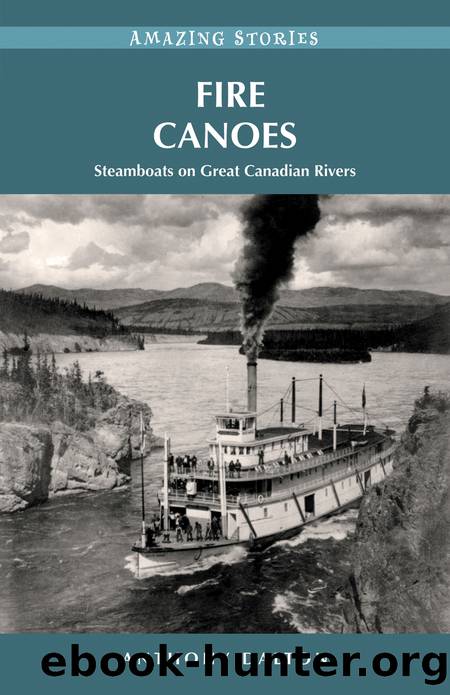Fire Canoes by Anthony Dalton

Author:Anthony Dalton
Language: eng
Format: epub
ISBN: 978-1-927051-46-7
Publisher: Heritage House
Published: 2012-04-15T00:00:00+00:00
It is believed that close to 300 steamboats of varying descriptions operated on the Yukon River, in Yukon and in Alaska, between the late 1800s and the mid-1950s. Of those, Portus B. Weare is said to have been the first steamboat to reach Dawson City after the news of the gold strike broke in the south. Portus B. Weare, 175 feet long and 400 gross tons, was in the right place at the right time. She had been working on the Yukon since 1892.
When Portus B. Weare steamed into sight one evening in late September 1897 she was greeted by enthusiastic crowds, all hoping the boat and those that came after her would be loaded with food supplies to help them through the coming winter. They were disappointed. Weare was followed two days later by the slightly smaller Bella. Neither boat carried food; both were laden with whisky and hardware, the latter presumably for mining purposes. When the two boats left a few days later for the run downstream to Fort Yukon, they carried disappointed prospectors trying to get out of the North before starvation and the harsh realities of snow and ice finished them off.
After a dreadful winter, and as the first week of June 1898 came to an end, a motley fleet of small boats began pouring into Dawson from the south. Among them were makeshift rafts, canoes, rowboats and sailboatsâanything that would float. The 134-ton steamboat May West arrived at Dawson City on June 8. Five thousand people lined the banks of the Yukon River to greet and celebrate her arrival. May West was followed by the much smaller Bellingham five days later. Bellingham, only 35 feet long, had been built on Bennett Lake in Yukon Territory in 1897 and was the first steamboat to navigate the upper Yukon River.
The Canadian Pacific Railway company (CPR) was quick to see the opportunities for growth into a new enterprise. In 1898, they advertised their preferred route to the Klondike, which stressed the value of the CPRâs railway network: âTake the Canadian Pacific Railway to Vancouver or Victoria, B.C.; thence ocean steamer via the inland channel to Fort Wrangel; river steamer up the Stikine River to Glenora or Telegraph Creek; pack trail or wagon road to Teslin Lake, and river steamer down the Hootalinqua and Lewes rivers to Fort Selkirk and Dawson City.â The CPR quoted the total distance as 1,542 miles.
At that time, the CPR did not have ships operating on the Inside Passage, nor did they have any vessels on the Stikine River. The companyâs directors soon took care of that gap in their service by purchasing two small ocean-going steamers from Englandâs Union Line: the 4,399-ton Tartar and a smaller sister ship, Athenian, at 3,877 tons. Both ships went into service on the Inside Passage in the spring of 1898. Steamboats for service on the Stikine River were not so readily available. They had to be built, and to keep expenses within reasonable limits, they had to be built locally, in Vancouver or a Washington shipyard.
Download
This site does not store any files on its server. We only index and link to content provided by other sites. Please contact the content providers to delete copyright contents if any and email us, we'll remove relevant links or contents immediately.
| Automotive | Engineering |
| Transportation |
Small Unmanned Fixed-wing Aircraft Design by Andrew J. Keane Andras Sobester James P. Scanlan & András Sóbester & James P. Scanlan(32155)
Navigation and Map Reading by K Andrew(4568)
Endurance: Shackleton's Incredible Voyage by Alfred Lansing(3867)
Wild Ride by Adam Lashinsky(1664)
And the Band Played On by Randy Shilts(1630)
The Box by Marc Levinson(1606)
Top 10 Prague (EYEWITNESS TOP 10 TRAVEL GUIDES) by DK(1574)
The Race for Hitler's X-Planes: Britain's 1945 Mission to Capture Secret Luftwaffe Technology by John Christopher(1533)
The One Percenter Encyclopedia by Bill Hayes(1473)
Girls Auto Clinic Glove Box Guide by Patrice Banks(1373)
Trans-Siberian Railway by Lonely Planet(1353)
Looking for a Ship by John McPhee(1328)
Batavia's Graveyard by Mike Dash(1309)
Fighting Hitler's Jets: The Extraordinary Story of the American Airmen Who Beat the Luftwaffe and Defeated Nazi Germany by Robert F. Dorr(1307)
Troubleshooting and Repair of Diesel Engines by Paul Dempsey(1290)
Bligh by Rob Mundle(1280)
TWA 800 by Jack Cashill(1258)
The Great Halifax Explosion by John U. Bacon(1235)
Ticket to Ride by Tom Chesshyre(1235)
